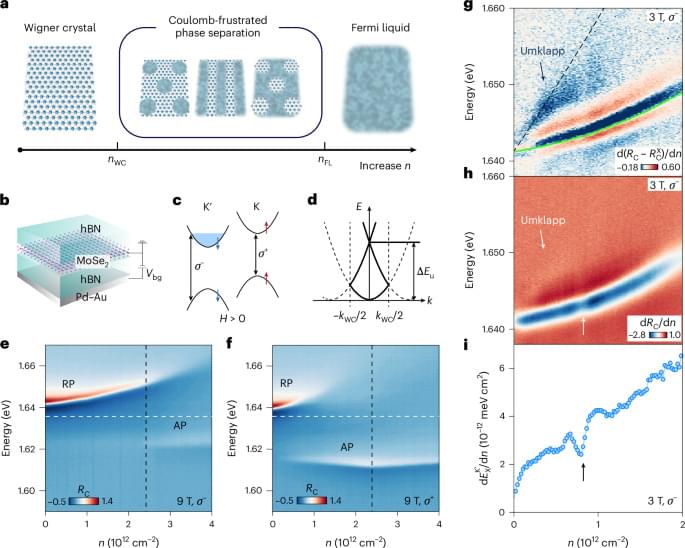Physicists explore particle scattering at tiny length scales.



PRESS RELEASE — Today, the U.S. Department of Energy (DOE) announced $71 million in funding for 25 projects in high energy physics that will use the emerging technologies of quantum information science to answer fundamental questions about the universe.
This research will develop and deploy innovative solutions for scientific discovery by applying the unique capabilities and features of the quantum world to the challenges of making new discoveries in fundamental physics. Awards funded under this program will advance theories of gravity and spacetime, develop quantum sensors that can see previously undetectable signals, and build pathfinder experiments to demonstrate increased discovery reach in searches for dark matter and other new particles and phenomena.
“Quantum information science is opening up new ways for us to understand and explore the universe,” said Regina Rameika, DOE Associate Director of Science for High Energy Physics. “With these projects, we are supporting scientists in developing quantum technologies that will empower the next generation of theory and experiment in high energy physics.”
Check out my own course on Brilliant! First 30 days are free and 20% off the annual premium subscription when you use our link ➜ https://brilliant.org/sabine.
Up until last week, physicists believed that matter is made up of only two types of particles: those whose spin has full-integer values (bosons) and those whose spin comes has half-integer values (fermions). But in a new paper, a group of researchers turned the world of physics upside down by mathematically proving that a third type of particles – the “paraparticles” are possible.
Paper: https://www.nature.com/articles/s4158…
🤓 Check out my new quiz app ➜ http://quizwithit.com/
💌 Support me on Donorbox ➜ https://donorbox.org/swtg.
📝 Transcripts and written news on Substack ➜ https://sciencewtg.substack.com/
👉 Transcript with links to references on Patreon ➜ / sabine.
📩 Free weekly science newsletter ➜ https://sabinehossenfelder.com/newsle…
👂 Audio only podcast ➜ https://open.spotify.com/show/0MkNfXl…
🔗 Join this channel to get access to perks ➜
/ @sabinehossenfelder.
🖼️ On instagram ➜ / sciencewtg.
#science #sciencenews #physics #math

Astrophysicists have long been intrigued by the possibility of dark stars-massive celestial objects fueled not by nuclear fusion but by the enigmatic energy of dark matter. Thanks to images taken by the James Webb Space Telescope (JWST), the scientific community has perhaps also found signs of such elusive entities. Could these dark stars, which shine billions of times brighter than our sun, rewrite the story of the universe’s infancy?
Dark stars, despite the word “dark”, are hypothesized luminous sources that may have existed in the universe’s infancy. In contrast to traditional stars that work with nuclear fusion, dark stars are speculated to obtain their energy from self-annihilation of dark matter particles.
As a result, energy is released that warms the ambient hydrogen and helium, and this leads the primordial clouds to glow brightly and expand to enormous scale-some up to a million times mass of the sun. These stars may have also been born in “minihaloes”, dense pockets of dark matter in the early universe.

The challenge for researchers is to develop the often complicated series of equations that are needed to describe these phenomena and ensure that they can be solved to recover information on the location of the objects over time. Often the systems of equations needed to describe such phenomena are based on partial differential equations: the series of equations that describe the location and time-evolution of a system are known as a distributed parameter system.
Mathematical models can help us not just understand historical behaviour but predict where the smoke particles will spread next.
Professor Francisco Jurado at the Tecnológico Nacional de México has been working on approaches to solve the problem of distributed parameter systems to describe diffusion–convection systems. He has recently developed an approach using a combination of approaches, including the Sturm-Liouville differential operator and the regulator problem, to develop a model for diffusion–convection behaviour that is sufficiently stable and free of external disturbances. Importantly, this approach allows us to yield meaningful information for real systems.

Competition between different possible ground states of strongly correlated electron systems can lead to the emergence of mixed states called microemulsions. Now this phenomenon is reported at the meltingion of a Wigner crystal.
In the world of tiny particles and quantum physics, scientists often study how electrons—the fundamental particles that carry electricity—behave under different conditions. When electrons interact strongly with each other, they can form various states of matter, much like how water can turn into ice or steam. Sometimes, these states compete, leading to complex and fascinating patterns. One such pattern is called a microemulsion phase, where tiny regions of different electron states mix together, creating a kind of quantum “patchwork quilt.”
In this study, researchers explored a special material called a MoSe₂ monolayer, which is an ultra-thin layer of atoms that can host electrons. By cooling this material to extremely low temperatures and using advanced light-based techniques, they observed something remarkable: aion between two electron states—a rigid Wigner crystal (where electrons are locked in place) and a flowing electron liquid. During thision, the electrons formed a microemulsion phase, blending crystal-like and liquid-like regions in a unique, self-organized pattern.
The team detected this phase by looking for specific clues, such as changes in how light reflects off the material, how the electrons respond to magnetic fields, and how they scatter off each other. These clues confirmed that the microemulsion is a distinct and exotic state of electronic matter, offering new insights into how electrons can organize themselves in surprising ways. This discovery not only deepens our understanding of quantum materials but also opens the door to exploring new phases of matter that could one day power advanced technologies.


Most of us assume reality is made up of physical matter. In line with this, scientists have built ever larger machines to identify the ultimate particles. Instead of getting closer to the most elementary bits in the universe, the particle zoo has got ever more complex and seemingly less like material stuff at all. Is there a danger that the very idea of an ultimate foundation to reality is a profound mistake? Some have proposed that instead of material, the ultimate foundation is to be found in consciousness, information, or even mathematics. But such proposals are no closer to identifying ultimate elements than particle physicists. Should we give up the attempt to uncover an ultimate foundation to the universe? Is our inability to find an ultimate foundation a limitation of language, or of our capacity to make sense of the world, or is it to do with the nature of reality itself?


For over 20 years, the Ihara research group at Ehime University has specialized in developing innovative methods for polymer synthesis using diazocarbonyl compounds as monomers.
They discovered that diazoacetate can be polymerized using a palladium (Pd)-based initiator to produce carbon–carbon (C–C) main-chain polymers, with each carbon atom in the backbone bonded to an alkoxycarbonyl (ester) group. Unlike traditional vinyl polymerization—where the polymer backbone is built from two-carbon units of vinyl monomers like ethylene and styrene—diazoacetate polymerization creates the C–C main chain from single-carbon units. This unique process, known as C1 polymerization, is a distinctive and significant feature of this synthesis method.